All the solutions provided in McGraw Hill Math Grade 3 Answer Key PDF Chapter 6 Lesson 1 Patterns in the Multiplication Table will give you a clear idea of the concepts.
McGraw-Hill My Math Grade 3 Answer Key Chapter 6 Lesson 1 Patterns in the Multiplication Table
Math in My World
Example 1
Enrique noticed he could find the product of two factors in the multiplication table. What is the product of 2 × 3?
The black numbers in the table are products. The column and row of blue numbers are factors.
1. Look at the two circled factors. Follow the numbers across and down until they meet. This is the product. Complete the number sentence.

2. Draw a triangle around the product in the multiplication table that has the same factors. Follow left and above to its factors. Draw a triangle around each factor Complete the number sentence.


____ × ___ = 6
The two number sentences are examples of the ____ Property of Multiplication.
Answer:
2 x 3 = 6
2 x 3 = 6.
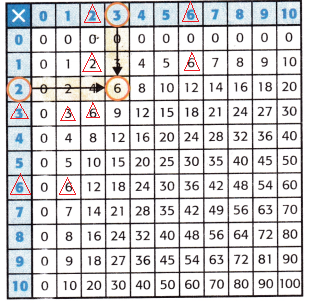
The two number sentences are examples of the commutative Property of Multiplication.
Example 2
Enrique found a pattern when he multiplied 4 by any factor.
Use a yellow crayon to finish Enrique’s pattern Write the numbers.
0, 4, 8, 12, ___, ____, _____, ____, ___, ___, ____

Circle whether the product of 4 and any number is even or odd
even odd
The product of 4 and 5 is 20. Write this product as the sum of two equal numbers.
____ + ___ = 20
Answer:
The patten is 4, 8, 12, 16, 20, 24, 28, 32, 36, 40.
The product of 4 and any number is even.
The product of 4 and 5 is 20.
The 20 has a sum of two equal numbers is 10 + 10.
10 + 10 = 20.
Example 3
Use a blue crayon to color the products with a factor of 3. What do you notice about these products?
The list of products with a factor of ___ increase by ____. It is as if you are counting by 3s.
Answer:
The factors of 3 are 1 and 3.
The product of factors of 3 are 3 x 1 = 3.
The list of products with a factor of 3 increase by 3.
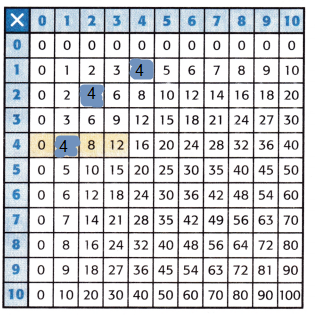
Guided Practice
Question 1.
Use an orange crayon to color the products with a factor of 5. What do you notice about the products in this row and column?
The products with a factor of ___ end in ___ or ___.
Answer:
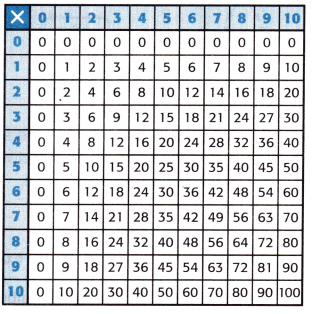
The 1 and 5 are the factors of 5.
The products with a factor of 5 end in 0 or 5.
There are two 5s in one of the column and two 5s in one of the row.

Question 2.
Use a purple crayon to color the products with a factor of 10. What do you notice about the products in this row and column?
The products with a factor of ___ end in ____.
Answer:
1, 2 5 and 10 are factors of 10.
The products with a factor of 10 end in 0.

Independent Practice
Question 3.
Shade a row of numbers blue that show the products with a factor of 2. What do you notice about the products in this row?
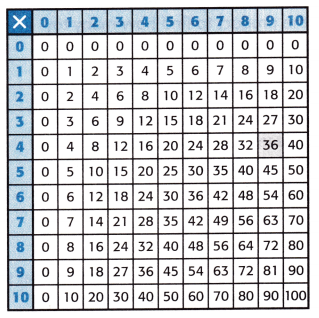
The 2s products end in ___, ___, ___, ____, or ___.
Are all the products in this row even or odd?
____________
Answer:
The 2s products end in 2, 4, 6, 8 and 10.
Are all the products in this row are even.

Question 4.
Shade a column of numbers green that show the products with a factor of 3. Describe the pattern of even and odd products.
Answer:
The factors of 3 are 1 and 3.
The even patten of products is 6, 12, 18, 24, 30.
The odd patten of products is 3, 9, 15, 21, 27.

Question 5.
Shade a row of numbers yellow that show the products with a factor of 1. What do you notice about this row?
Answer:
1 is the factor of 1.
The product of the factors 1 is 1 x 1 = 1.
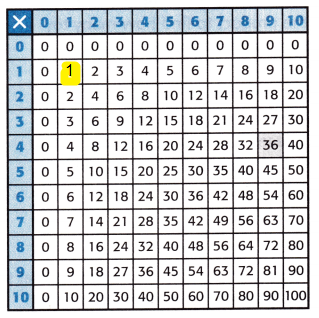
Question 6.
Look at the product shaded gray Circle the two factors that make this product. Complete the number sentence.
4 × ___ = 36
Draw a triangle around the product that has the same factors. Draw a triangle around each factor. Complete the number sentence.
9 × ___ = 36
The two number sentences show the ____ Property of Multiplication.
Answer:
The number sentence is
4 x 9 = 36
9 x 4 = 36
The two number sentences show the commutative Property of Multiplication.

Problem Solving
Question 7.
Layne packed 3 toy cars in each of 4 cases. Circle the factors and shade the product to find how many toy cars Layne packed.
____________

Joey packed 4 toy cars in each of 3 cases. Circle the other two factors and shade the product to find how many toy cars Joey packed.
____________
Answer:
Given that,
Layne packed 3 toy cars in each of 4 cases.
So, 3 x 4 = 12
Joey packed 4 toy cars in each of 3 cases.
So, 4 x 3 = 12.
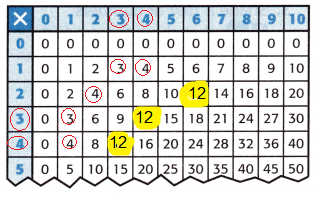
Question 8.
Write the two number sentences that show the ways each boy packed the toy cars in Exercise 7.
____________________
Which property is this an example of?
____ Property of _____
Answer:
The two number sentences are
3 x 4 = 12
4 x 3 = 12.
It is a commutative property of multiplication.
HOT problems
Question 9.
Mathematical PRACTICE 7 Identify Structure Write a real-world problem for which you can use the multiplication table and the Commutative Property of Multiplication to solve. Then solve.
Answer:
The real world problem is there are 9 ropes and you need 3 people per one rope. write the number sentence.
The number sentence is 3 x 9 = 27.
9 x 3 = 27.
It is commutative property of multiplication.
Question 10.
? Building on the Essential Question How can a multiplication table help you multiply?
Answer:
Multiplication table is used to define the multiplication operations for the algebraic system.
McGraw Hill My Math Grade 3 Chapter 6 Lesson 1 My Homework Answer Key
Practice
Question 1.
Look at the products with a factor of 5. What pattern do you see? The products with a factor of 5 end in ____ or ____.
Answer:
The factors of 5 are 1 and 5.
The products with a factor of 5 end in 0 and 5.
Question 2.
Look at the products with a factor of 0. What do you notice? The products with a factor of 0 end in ____.
Answer:
The product with a factor 0 is 0.
The product with a factor of 0 end in 0.
Question 3.
Find 10 × 5. Circle the factors and the product. Write the product.
Answer:
Given that is 10 x 5.
10 x 5 = 50.
10, 5 is the factors and 50 is the product.
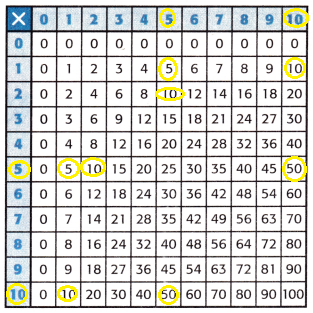

Question 4.
Shade a row of numbers yellow to show the products with a factor of 10. What do you notice about this row?
The products with a factor of 1o end in _____.
Answer:
The factors of 10 are 1, 2, 5 and 10.
The products with a factor of 1o end in 0.
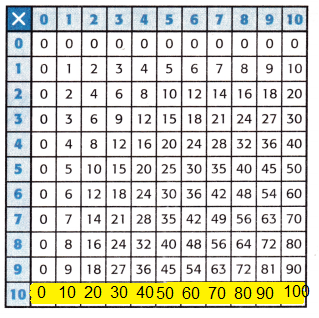
Problem Solving
Question 5.
Mathematical PRACTICES 4 Model Math Mason has 1 notebook for science and 1 notebook for reading. He put 9 stickers on each notebook. How many stickers did Mason use in all? Write two multiplication sentences.
Answer:
Given that,
Mason has 1 notebook for science.
And he has 1 notebook for reading.
The total number of books are 2.
He put 9 stickers on each notebook.
The number of stickers in all is 9 x 2 = 18.
The two multiplication sentences are 9 x 2 = 18.
2 x 9 = 18.
Therefore there are 18 stickers in all.
Vocabulary Check
Question 6.
Label each with the correct word.

Answer:
Given that,
4 and 2 are factors.
8 is the product.

Test Practice
Question 7.
Which property states the order in which two numbers are multiplied does not change the product?
A. Associative Property of Addition
B. Commutative Property of Multiplication
C. Inverse Operations
D. Identity Property of Addition
Answer:
In the commutative property of multiplication the order in which two numbers are multiplied does not change the product.
Option B is the correct answer.